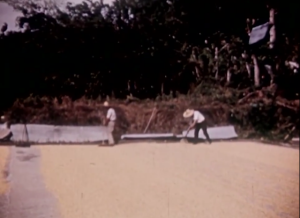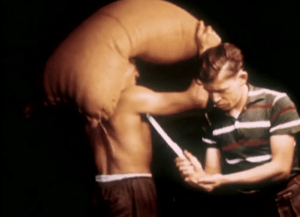If you ask us, it’s almost always a good time for coffee. In the spotlight this week is an educational/promotional film made by A&P, who started in the 1800s as with a chain of shops offering coffee and tea. By the 1950s, they were operating full self-serve grocery stores with a trail of shuttered mom and pop operations in their wake.
This is the story of coffee as it goes from the nursery to the field to the shelves of your local A&P. It covers the growing, cultivation, and distribution of coffee from South American crops that at the time covered more than one million square miles of Brazil alone.
Coffee trees leave the nursery at two years old and are planted in nutrient-rich red soil. Two to three years later, they bear their first crop. Coffee blossoms appear first, and the fruit ripens over the next 8-9 months. Skilled workers pick the berries by hand. We are told that the average tree produces one pound of roasted coffee per year.
 The day’s harvest is collected, weighed, and bagged for further production. The fruits are crushed to remove each bean from its red jacket. Then, the beans are washed and spread out in the sun for 8-10 days. They are frequently rotated so they dry evenly. The dried coffee is packed in bags and sent into the city.
The day’s harvest is collected, weighed, and bagged for further production. The fruits are crushed to remove each bean from its red jacket. Then, the beans are washed and spread out in the sun for 8-10 days. They are frequently rotated so they dry evenly. The dried coffee is packed in bags and sent into the city.
 At a warehouse, the coffee is inspected, sorted, and graded. Bags are stamped with the coffee’s country of origin and intended destination before going to the seaport. A very important step happens here. As each bag walks by on the shoulders of a worker, another guy stabs it to get a sample of the beans. The on-site A&P officials take over at this point and do their own inspections, sending samples to the US. Here, the coffees are roasted and taste tested for both strength and flavor from a giant lazy Susan full of porcelain cups.
At a warehouse, the coffee is inspected, sorted, and graded. Bags are stamped with the coffee’s country of origin and intended destination before going to the seaport. A very important step happens here. As each bag walks by on the shoulders of a worker, another guy stabs it to get a sample of the beans. The on-site A&P officials take over at this point and do their own inspections, sending samples to the US. Here, the coffees are roasted and taste tested for both strength and flavor from a giant lazy Susan full of porcelain cups. 
The film takes a brief detour to tell us that the great cities of Latin America were built upon the labors of coffee exportation. We see a montage of vistas, skylines, and shorelines, which bring it back to the subject of shipping the coffee to various ports of call. At the dock, bags are tumbled onto large nets to be loaded on the ship. As coffee is susceptible to moisture, special care is taken to avoid the ill effects of traveling out of the tropics.
Retrotechtacular is a weekly column featuring hacks, technology, and kitsch from ages of yore. Help keep it fresh by sending in your ideas for future installments.
















A&P was the most incompetent grocery store chain ever
Go for a vacation in the Adirondacks, why are there no grocery stores anywhere? A&P, that’s why.
Here’s a mashup using some of this old video, Caffeine Trance.
https://vimeo.com/2061156
I read this article with the History Channels Modern Marvals narrator voice
Poll time. Who:
a) Watched this while enjoying a cup of coffee?
b) MST’ed the video?
c) Enjoys the happydapper music in these old videos?
d) Was disappointed by not seeing a burro, like in the old coffee commercials?
e) Wants to apply for a job as a coffee taste tester?
f) Thinks coffee beans look a little like cranberries, and wonders if they could genetically engineer caffeinated cranberries?
e) all of the above
g) I obviously need coffee
h) Isn’t so self-indulgent.
Umb burro at 3:20!
Wash your eyeballs if you didn’t see the burros.
A&P = The Great Atlantic & Pacific Tea Company
http://www.aptea.com
I didn’t realize they were still in business…
I started doing this for fun in my early teens and now that my 40+ trees are growing it will be done more…
You use a food processor with plastic blades to remove the pulp, dry the beans out, then run them through the food processor to knock the parchment off, and then roast with a heat gun. It’s almost always a few steps above store bought coffee… Still can’t get cacao pods to process though :/
You, good sir, are master of the most important fuel. I bow to your foresight and wish I had land.
A&P 8 O’clock coffee was up the street from me in Landover Maryland where they would roast it and ship it out. The sign has been removed but they still roast coffee there.
I used to have a friend that worked there ~20 years ago as a coffee inspector.
He would go to Baltimore to grade the coffee bean shipments.
At one time they supplied all of the 7-11 convenience stores on the east coast with those pre-measured coffee packs. If you drank 7-11 coffee back then you probably had A&P 8 o’clock coffee.
When I retire (ha!) I want to try mutating some coffee beans to grow in Colorado dirt without exhausting the soil too much. I figure that it’ll taste like crap, but somebody will want to purchase coffee mass produced in the CONUS if it were available
If you are really into it you could probably pull it off in a greenhouse. They handle high altitudes well, and naturally grow in shade. Shoot for Arabica and not Robusta though :)
The good ol’ Atlantic and Pacific. I grew up with one of these a few miles away. They didn’t have anything specific going for them (essentially an IGA but under the A&P name). The highlight for me as a child was their “serve yourself” Voortman cookie display… those Dutch Windmill cookies with the almond slices embedded in them… heaven, pure heaven. Throw in some sugar wafers (vanilla, chocolate, strawberry, whatever… not much actual taste difference) and maybe a few iced oatmeal raisin cookies too (more like raisin flecks as opposed to actual raisins, but they were very shelf-stable that way).
This was doubly appealing to me because our local Radio Shack franchise store (more of a cave really, part of the store was a Quonset Hut) was directly across the street. There was something oddly appealing about those dimly lit shelves full of Tandy cassettes and batteries (the better stuff was displayed above my eye level, so the cassettes and batteries are most of what I remember). A trip to A&P and the to Radio Shack made for a very pleasant summer day.
Wow, I haven’t seen an A&P in a very long time. Thanks for the great video and for the trip back down memory lane!
I’ve tried many, many times to get coffee to grow indoors, in Massachusetts. They say it’s no harder than growing a ficus.
Come to think of it, I don’t actually know anyone who’s managed to successfully grow a ficus.
Might need so much heat and light you’d get a visit from the DEA?
Well, caffeine *is* a drug…and addictive (but legal…so far)
:-)
Hey how timely for me! I just started home roasting in my diy roaster because commercial ones are way to expensive. If your interested in seeing these beauties being changed into the best coffee in the world check out paulscoffeeadventure.com. sorry if that’s a shameless plug, its just my personal site and I’d love to share the fun
I was strongly recommended by my school at the age of 13 to drink coffee. It was all good until 23 when I had an anxiety attack. With some advice I switched to decaf and all was good for 30 years. Then the acid in the coffee was killing my stomach.
It was really hard to quit coffee. Not due to the caffeine “remember I switched to decaf years ago. No I just miss that time in the morning sipping on a cup reading hackaday. I’ve been looking for a substitute for a while and tea, chai just don’t cut it.
I roast coffee at home now and then. It’s a pretty simple process when you put only one layer of coffee beans in a toast oven for about 15 minutes at about 180°C. Depending on the oven, of course. No stirring needed. No heat gun. No popcorn maker.
“As coffee is susceptible to moisture, special care is taken to avoid the ill effects of traveling out of the tropics.”
Oh, and I use http://en.wikipedia.org/wiki/Monsooned_Malabar coffee. Interesting story right there…
A living history exhibit at our Feast of the Hunters Moon caught my curiosity a few years back. The setting: 1750 meeting of French, Indian, British, and settlers on the Wabash.
I see a redcoat as an apothecary selling herbs, lobelia, mint, capsicum, opium, hashish, etc.
I ask “you got any leaches”.
No sir it’s to cold and they are too expensive.
“Where do you get (pointing to the drugs) this”.
Oh from the great Atlantic and Pacific Tea Company of course!
Caffeine the actual gateway drug. The first recreational drug most use to alter their mood.